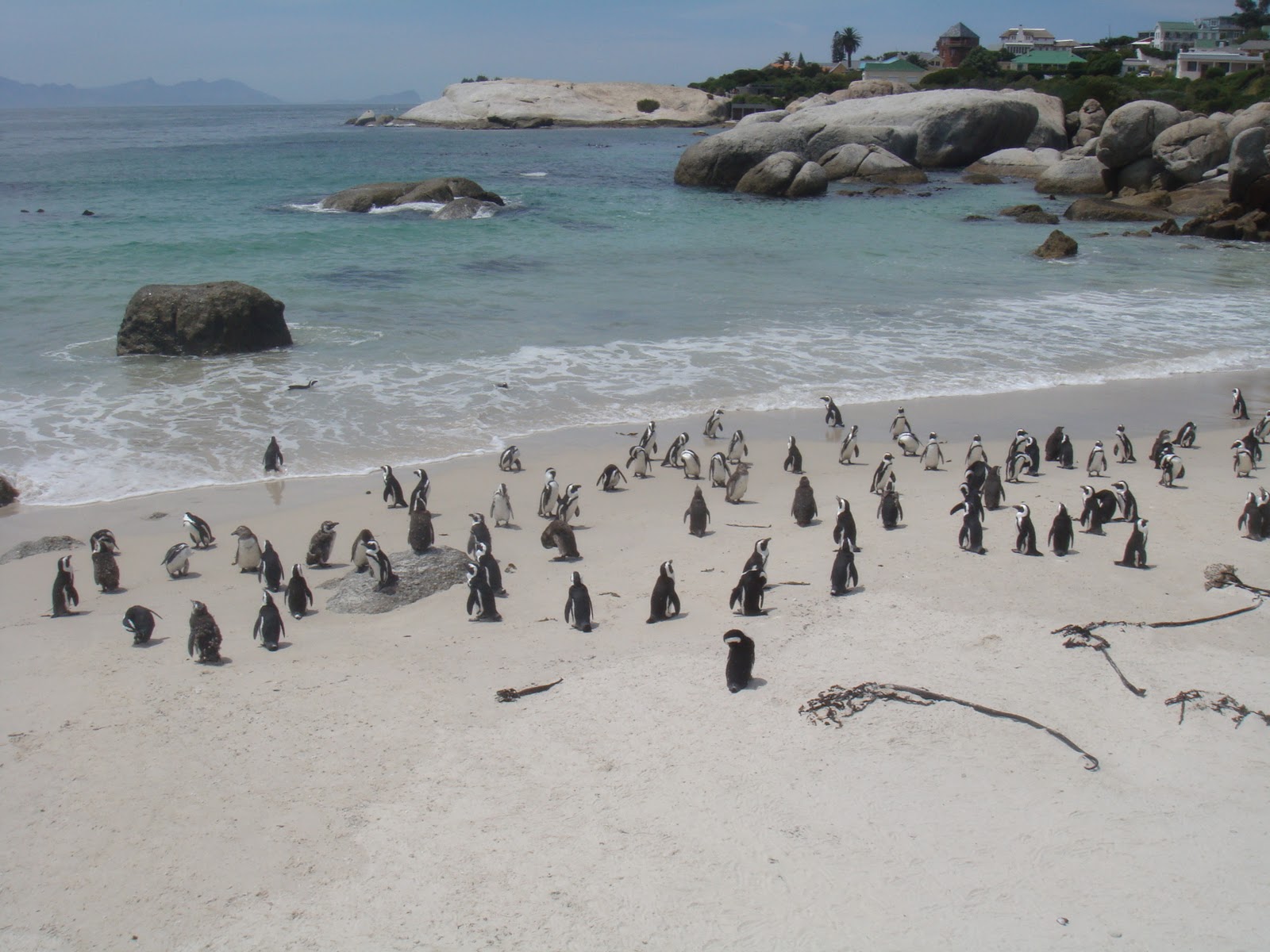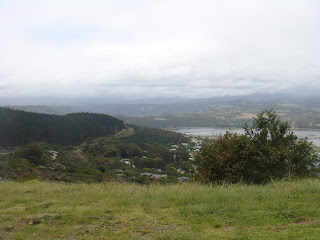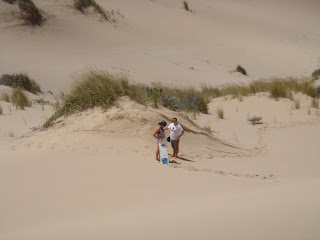121 days away; 5 different countries; 10 flights totalling over 63 hours; 23,000 miles flown; over 10,000 miles driven; 29 different hotel and hostel rooms and; 30 days in a campervan. We have suffered the stress of two strikes, although luckily escaped the pain of both, had two moments of madness jumping out of a plane and off a bridge, and received 1 parking ticket (thank you Australia), and one speeding fine (thank you New Zealand), although there may be more waiting for us at home! Most importantly however, we have met lots of interesting people, and have thousands of brilliant memories to go with the 7,000 photos, which we will never forget, and never regret. Thank you for taking the time to bother reading our drivel, we hope it was entertaining, or at least mildly interesting! So until next time (!) this will be our last blog...see you all very soon!
Round the World
Caroline and Ryan's Round the World trip
From the 11th August we'll be departing the UK, stopping in Vegas, LA, Fiji, New Zealand, Australia and South Africa. Hopefully through this blog we will be able to keep you all updated and show you what we've been up to. It would also be really great to here all your news, so feel free to comment and update us too!
Tuesday, 29 November 2011
Monday, 28 November 2011
Cape Town
For the last few days we’ve been exploring Cape Town itself, and have been keeping pretty busy! First on our ‘to do’ list was the Slave Lodge, a museum housed surprisingly enough in the old Slave Lodge, where slaves lived (and died) during the Dutch rule. The museum basically explains and illustrates South Africa’s history of slavery, which was really interesting.
As well as the Slave Lodge, we have visited Robben Island, which is I guess best known as the location of the maximum security facility that housed political prisoners during South Africa’s apartheid rule. Visiting the island includes a bus tour, on which you see the house in which Robert Sobukwe (leader of the Pan Africanist Congress) lived in solitary confinement for nine years. We also visited the lime quarry where Nelson Mandela, along with many other prisoners worked for years, causing significant damage to their eyes due to the brightness of the limestone in the African sun. Also on the island we visited the prison, where we were guided by an ex-political prisoner. Our guide was sent to Robben Island in 1984 with a 25 year sentence, meaning he wouldn’t have been released until 2009 if the apartheid rule had not ended in 1990. In the prison we visited a number of the tiny cells that housed inmates, including Nelson Mandela’s cell, which is exactly as it was during his 18 year stay. We also saw the make-shift tennis courts the prisoners engineered, allowing them to pass messages to each other by lobbing tennis balls (with messages inside) over the building! Interestingly, during their stay on the island, a lot of the prisoners gained a comprehensive education, with many leaving with a number of university degrees. At a more basic level, such education started with the prisoners motto of ‘each one, teach one’, illustrating how Robben Island was quite unlike other prisons in the sense of unity between inmates. Unsurprisingly, therefore the island is legendary in South African history, concentrating the energies of liberation. The current President of South Africa was also a prisoner on the island.
We have also been up Table Mountain via the cable car. The views from the top are so amazing, giving a 360 degree view of the city and the cape. From certain points at the top it is possible to see all the way down to Cape Point at the end of the cape. You also get a brilliant view of the Twelve Apostles, as well as being able to see across to the Cape Flats which stretch east from the city. The cable car itself was pretty impressive also, as the floor rotates as you travel up and down, completing a full 360 degree rotation as you journey from bottom to top and vice versa.
As seems to be a habit on this trip, we also visited the Houses of Parliament, which are housed in Cape Town (being one of the three capital cities of South Africa). It was interesting to see how the current administration use the same rooms as were used by the Apartheid Government, without change. Our guide also told us that although South Africa’s parliament works on a two-house system like many other democracies globally, both houses are equal in power. We also found out how the ministers get past the obstacle of the eleven official languages spoken in South Africa (permanent translators!).
Escaping the cultural side of things, we have also visited the V & A waterfront; the most unAfrican place we’ve visited in South Africa! You could be anywhere in the western world with Subway, Accessorize, Mango and Havianna all present. It is however, a really nice place to while away an afternoon in the sunshine whilst watching the boats, especially as the Volvo Ocean Race is currently passing through.
Wednesday, 23 November 2011
Cape Point
We’ve spent the last few days exploring the Cape for which Cape Town is named. Our first stop was to see yet more penguins! This colony live at Boulder’s Beach, and are the other of the two land-based African penguin colonies. These penguins were a lot less smelly than the penguins at Betty’s Bay, possibly as there are fewer of them, and they live on the beach, but whatever the reason we were grateful! The penguins were not the only interesting animals we’ve seen on the cape so far. When driving down to Cape Point on the south of the cape we passed numerous signs about the dangers of feeding baboons. A few miles on and we spotted three of the men they employ here to ‘protect’ tourists and motorists from the baboons. All three of the men had wooden sticks, which they smack on the ground near the baboons if they’re ‘misbehaving’! A few metres from the three men we spotted a group of baboons lying by the side of the road in the grass. A couple of the larger baboons were walking around predatorily, eyeing up the cars that had stopped to take pictures. The baboons are far from stupid and know that both humans and their cars are often a brilliant source of food. Consequently, we stayed in our car with the doors locked and windows closed, however some silly tourists weren’t so sensible, leading to a little baboon tourist chase, that was brilliant entertainment! We also got to see firsthand how sneaky the baboons can be, when one of the larger ones walked up to a parked car and tried first the front door and then the back door to see if it could get in! Amazing to watch! As well as baboons chasing humans, we watched as three of the younger baboons fought each other, rolling and jumping all over the place. We also saw a tiny baby baboon, who was playing on the other baboons whilst they were being groomed!
After watching the baboons we headed south to the Cape of Good Hope section of Table Mountain National Park. The Cape of Good Hope itself is a specific point within the park: the most south-westerly point of the entire African continent. In addition, the park is home to Cape Point, which is commonly mistaken as the most southern point in the continent, as well as being where the Atlantic and Indian Oceans meet. However, the Cape holds neither of these titles, but is more commonly visited than the Cape that does (Agulhas), being far more picturesque.
On our drive back north towards Cape Town we travelled along Chapman’s Peak Drive, which is apparently one of the world’s best coastal drives. The drive took us to first Hout’s Bay and then Camps Bay – two of Cape Town’s more affluent suburbs, both of which are beach towns. Although both towns are perfectly lovely, it is their setting against Table Mountain and the Twelve Apostles that draw the crowds!
Whales, penguins and wine
After the Garden Route, before you reach Cape Town there is an area of South Africa which is known along the coast as the Whale Watching Coast, and inland, the Winelands. Our first stop in this area was at Hermanus, a town famous for the high numbers of whales that pass throughout the year. There are so many whales in fact, you can just stand on the cliffs in the town and watch the whales frolicking and spouting water just metres away. It was so brilliant to watch the whales breaching and swimming around on the surface of the water – we even saw one lift and wave its tail at us! About half an hour along the coast from Hermanus is a small town called Betty’s Bay, where an African penguin colony lives. The colony are one of only two colonies in the whole of the African continent that are based on the mainland. As soon as you arrive at the point where the penguins live you can smell them! It’s a smell like nothing else, and it is so so disgusting – think a mix of gone-off fish guts mixed with every other herendous smell you can think of! Yuck! The penguins themselves where amazing however, and there were so so many of them, all just standing round, mostly looking at us looking at them! After the smell became just too much we headed inland to check out the hundreds of wineries that are located in this area of the cape. We visited a winery called Die Bergkelder, which is apparently one of the first of the wineries that were established in South Africa. In addition to sampling the wine (which we were encouraged to swallow!), we had a tour of the winery, seeing the cellar where they mature the wine as well as the machines they use to produce the wine and the actual vines they use. It is suggested that you visit four or five wineries on a mini tour, however after one we decided an afternoon lying in the sun would be far more beneficial!
Spot the whale!
Friday, 18 November 2011
The Garden Route - Part 2
Our first stop on the second half of the Garden Route was Knysna, pronounced “Nice Nah”. The town is famous for its forests which used to be home to around 400 elephants, but now only around 4, so needless to say we didn’t see any whilst we were walking through! As well as the forest, Knysna is home to a massive lagoon which exits into the Indian Ocean through a narrow gorge called the Heads, and a beautiful 5km long white sandy beach, which is backed by huge vegetated cliffs, and littered with jelly fish!
Our next stop was Mossel Bay, which claims to be one of the best places to go shark diving in the world. It is also said that it has some of the best swimming beaches in the Southern Cape – we’re sure the sharks would agree! The beaches were lovely but the water is freezing cold; the only reason we didn’t go swimming, absolutely nothing to do with the sharks...!
Mossel Bay is also home to some large sand dunes which stretch along the coast from the town, on which you can sandboard. We tried two types of board, one which you either sit on or lie on, and then a snowboard, which obviously allows you to board down the dunes standing up. We started with sitting on the first board and flying down one of the smaller dunes into the bowl below. Our ‘instructor’ then taught us to sandboard on the snowboard. This wasn’t quite as easy for some as sitting on the board, especially at the base of the dune when the sand levels out – needless to say Carrie’s bum is nicely bruised! After we’d snowboarded down a few more times we moved up to the largest of the dunes, which has a run of 350m. For safety reasons they don’t let you snowboard down this one, they just suggest you go head first on the smaller board at great speed – obviously better! Boarding down was brilliant, especially as you could really get up speed. Unfortunately going down 350m means you have to come back up 350m, and this isn’t quite so much fun, and far from fast! We managed to struggle back up and flew down again, but after the second mammoth dune climb, we called it a day! A pretty fun one though!
The Garden Route - Part 1
As you know, from Jo’burg we flew to Port Elizabeth, with the plan being to drive from here to Cape Town. One of the key things that you can’t help but notice in South Africa is the poverty and the racial divide that accompanies it. Although we passed a number of townships in Jo’burg, in Port Elizabeth we got to see them first hand, visiting Red Location, the city’s oldest African township, and a significant area in the anti-apartheid struggles. The area has grown significantly since 1902 when it was first established, with a number of other townships emerging around it, including New Brighton and Kwaford. Seeing such ‘slums’ on TV and in real life just doesn’t compare. The most overwhelming thing is the rubbish: it is absolutely everywhere, mountains of plastic bottles and strips of carrier bags, with the worst thing being the numerous people sifting through them all, along with a number of pigs and stray dogs. Passing further into the township you see how some of this rubbish is used, with some of the ‘houses’ having roofs made of black polythene bags, and windows boarded with cardboard. These ‘houses’ are probably not even 6ft by 6ft, and many in this area don’t have any sanitation. Some however, are serviced, with the luxury of an inside toilet and running water, yet are still often built from odd bits of wood and haphazardly assembled breeze blocks at best. And yet, five minutes drive away brings you to massive mansions barricaded on all sides with electric fences and armed response signs adorning every wall, with large, luxurious malls and restaurants lining the streets. This division is not exclusive to large towns and cities such as Port Elizabeth and Johannesburg however, everywhere we have visited on the Garden Route has a township just outside the main town, with a number being a lot worse off than those we described in Port Elizabeth.
Our first stop after Port Elizabeth was Storms River Mouth (near to where Ryan did his bungy jump), where Storms River exits through a huge gorge in to the Indian Ocean. A pedestrian suspension bridge spans the river mouth, from which you can watch the water coming rushing through the gorge. Just on from Storms River Mouth we stopped off at a place called The Crags, where we visited an elephant sanctuary. At the sanctuary we were able to feed, stroke and walk with the elephants. Walking with the elephants was especially amazing, as they place their trunks in your palm, and you lead them through the forest. As an elephant’s trunk is their main airway they are constantly blowing hot air out onto your hand as you walk, which was a lovely experience! Especially as it’s not the cleanest of air as they’re constantly hovering the floor for food! The guides also told us about all the different parts of (African) elephants, including the fact that they die of starvation, as their teeth wear down from years of chomping, and they can no longer chew their food. They also said that if they feed the elephants too many oranges they come out whole in their dung as elephants only digest around 40% of what they eat!
After visiting the elephants we drove on to Plettenberg Bay, which is known as the ‘flashiest’ of the Garden Route’s seaside towns, attracting the residents of Johannesburg’s richest suburbs over Christmas. The town itself however, didn’t seem that amazing to us, just a few tourist shops and a lot of houses. There is a nature reserve a few kilometres out of the town however, that was beautiful. The Robberg Peninsula stretches out into the Indian Ocean, giving the town it’s ‘bay’ status. The 8km walk around the peninsula was mostly along steep narrow cliff paths, with a lot of scrambling and clinging on for dear life! But the views were spectacular, especially the huge colony of seals that live at the base of one of the cliffs, which we smelt long before we saw them! It was brilliant to sit and watch them basking on the rocks and jumping and diving everywhere in the nearby waters.
Subscribe to:
Comments (Atom)



































































